#1954-55
Text

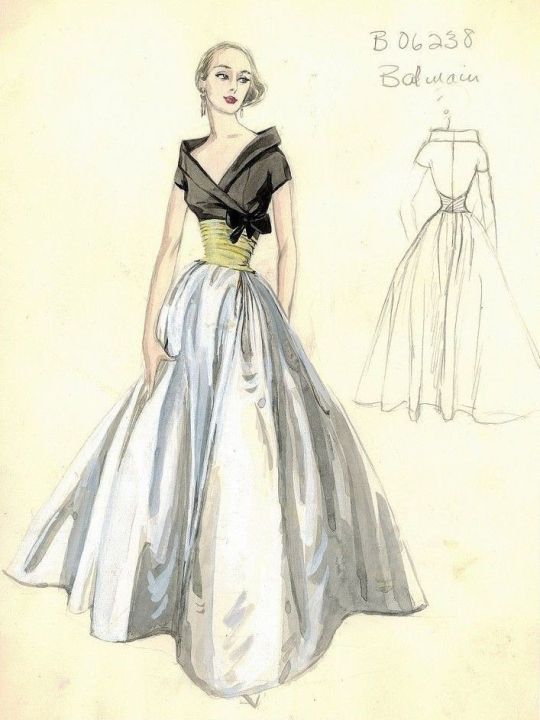
Pierre Balmain Haute Couture Collection Fall/Winter 1954-55
Marie-Hélène Arnaud wears a dress with a black satin bodice by Bodin and a white satin skirt by Staron with a draped yellow satin belt.
(below) Sketch of the Bergdorf Goodman House.
Pierre Balmain Collection Haute Couture Automne/Hiver 1954-55
Marie-Hélène Arnaud porte une robe à corsage en satin noir de Bodin et jupe en satin blanc de Staron ceinture drapée en satin jaune.
(dessous) Croquis de la Maison Bergdorf Goodman.
Photo Philippe Pottier.
#collection haute couture#fashion 50s#1954-55#french designer#french style#fall/winter#automne/hiver#pierre balmain#marie-hélène arnaud#philippe pottier#bergdorf goodman#staron#bodin#evening gown#robe du soir
55 notes
·
View notes
Text
(Beauty and the beast steddie)
No.6 — Stay
As Erica stated, the kids are nerds — surprisingly, even Erica herself.
So obviously the kids get interested in Eddie's stuff, the fantasy books and Dungeons and Dragons manuals and more (turns out they have been big fans of Lord of the Rings since the 50s). And now Eddie is indulging them in the world of fantasy within and beyond Lord of the Rings — that means, he's started to recount his memorable Dungeons and Dragons campaigns to them in the living room. He loves introducing dnd to kids, loved it when he ran the Hellfire club. He wonders if he can play it with these kids. Hopefully.
Eddie thinks he's got the time for it anyway. The storm is still evergoing, painting the world in a gray hue. He didn't expect to be staying here—for two days already— but he guesses it's nice. The kids. Nancy. Steve.
Steve. Since last night's talk, he already feels close to the guy. Eddie feels curious, about why he won't come out, and he nearly gets bitten by Erica when he spaces out thinking about Steve.
That's when a crow runs in.
It's a weird thing to say in your head. Why is it not flying? And how does a crow look so excited? But the kids all act like this is a normal occurrence, so Eddie decides to stay chill, too.
Not having noticed Eddie yet, (which is surprising because he is the biggest lump there) the crow urgently asks,
"Is the Eddie guy still here?"
And quickly finds him herself.
"Good, you're still here. You're staying. I mean, I'm not forcing you to stay, but I'd really like if you did. For a bit longer. You're like, a crazy good thing that's happened to us. Those dorks love you, Nance likes you okay too, And Steve, Steve likes you, he's in a good mood and that's—"
"ROBIN!"
The crow's rambling is only stopped by Steve's voice yelling from upstairs, and Eddie is honestly impressed. He's never seen anyone talk so fast, without control. The crow, Robin, only turns her head towards the stairs and shouts, "Shut up, dingus! I'm trying to do something here, for all of us!"
That causes Steve to grumble, very loudly, from upstairs and shut the door with a bang. Robin doesn't even flinch and turns back to Eddie.
"So, will you stay? With us, for a while?"
Eddie makes a pondering gesture, as if he's thinking it through thoroughly. The kids twitch beside him, waiting for his answer.
"I mean, I couldn't have left if I wanted to right now—not that I want to anyway— but yeah I'll stay, under one condition. That is, only if you answer this question."
"Shoot."
Eddie turns his expression serious, as if he's asking the most difficult question to ever exist.
"Why are you not flying?"
He doesn't know how it's possible, but Robin gives him an incredulous look.
"Have you-, have you tried flying? It takes up more energy than you can imagine. Like, I flap my wings a bit and they get really tired, it gets sore for days after, so it's best if I walk. Or hitch a ride from Steve and Max."
And that... kind of makes sense, okay. So Eddie shrugs to show he's satisfied with the answer.
"Alright, guess I'll be staying then."
***
"So," Eddie begins, leaning his head on the doorframe.
"I guess I'll be in your hair for a while."
Steve's voice comes from behind the door, maybe as close to it as Eddie is right now.
"I guess you will be."
They are talking with the door between them again, Eddie and Steve. This is the fourth time it's happening, because Eddie couldn't stay away after last night and just came back to the door whenever he could. He kind of likes talking like this, he's never talked through doors and somehow it feels more private, more intimate.
"Eddie, about what Robin said—"
Eddie hums, recalling the talk from before.
"Don't-, don't feel pressured to stay, okay? We, uh, the kids love you here but that doesn't mean you have to stay for us. Do... whatever you want. Go wherever you want."
Eddie gives another hum.
"You know, Steve, thanks for the offer but I like it here. Don't have anywhere else to go, anyway. I was only moving out of Indiana because I finished high school and had nothing to do and nowhere to go. Had no place in mind, actually."
Maybe this is where I was supposed to end up.
"So... yeah. I'm not staying only for the kids but for me, too."
There's a pause.
"Yeah?" It's a soft question, looking for affirmation.
"Yeah," Eddie answers.
And then he hastily adds, "And for you, too— since you like me sooo much, Stevie," just because he loves being a menace.
Eddie hears Steve's groan slip out through the crack and cackles.
"Well, don't worry— I like you too, man."
#stranger things#steddie#eddie munson#robin buckley#steve harrington#beauty and the beast au#lotr was published in 1954-55#must have been a brand new book to the kids#and dnd was first published in 1974#wow#i get carried away when i try to write historical stuff#i try not to be but#the word dingus was first used in late 19c
27 notes
·
View notes
Photo

Rudy Grayzell & His Jury, probably 1954/55
6 notes
·
View notes
Text
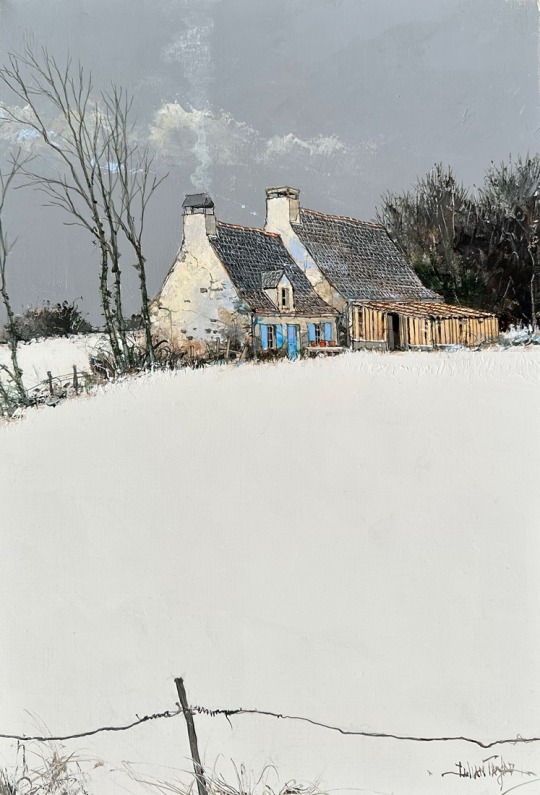
Soft winter sky , Périgord - Julian Taylor
British , b. 1954 -
Acrylic on canvas . 55 38 cm.
899 notes
·
View notes
Text
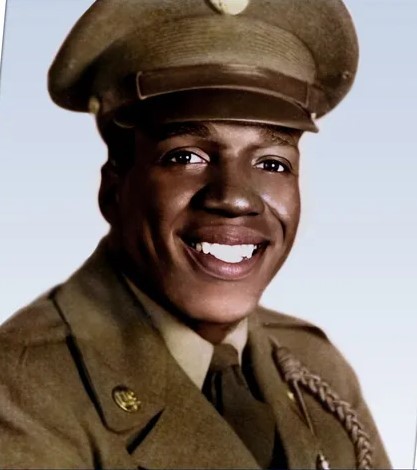
December 27, 2015, Harlem Globetrotter Meadowlark G. Lemon died at 83.
Meadowlark George Lemon III was born in Wilmington, North Carolina, on April 25, 1932. He discovered the Harlem Globetrotters at 11 years old while watching a newsreel at the local theater. He was determined to one day make the team. Lemon didn’t have enough money to buy basketball equipment, so he made his own. He made the Basketball hoop out of an onion sack and a coat hanger and used an empty carnation milk can as his ball. According to Lemon, he made his first shot, a two-pointer.
He continued to play basketball in high school. Realizing the fierce competition, he logged long hours on the court to strengthen his skills. He briefly attended Florida Agriculture and Mechanical University, a historically black university in Tallahassee, Florida. He was drafted into the Army in 1952. He completed basic training at Fort Jackson, South Carolina, before serving two years in Salzburg, Germany.
While in Germany, Lemon played on an Army base’s basketball team, averaging 55 points a game. He was discharged in 1954. He then played for the Kansas City All-Stars for a year before joining the Harlem Globetrotters. Lemon played for 23 consecutive years with the Harlem Globetrotters and earned the name “Clown Prince of Basketball.” In the 1980s, he started his comedic basketball team “Meadowlark Lemon’s Bucketeers,” and then he established “The Shooting Stars” before founding “Meadowlark Lemon’s Harlem All-Stars.” Lemon returned to the Harlem Globetrotters in 1993 for a 50-game season.
In 1986, Lemon became an ordained minister. In 1989, he founded “Camp Meadowlark,” a camp designed to improve young people’s basketball skills while teaching them the importance of education and staying healthy. He earned his Doctor of Divinity in 1998. In 2003, Lemon was inducted into the NBA Basketball Hall of Fame.
Photo: Meadowlark Lemon. Courtesy of Veterans Affairs
507 notes
·
View notes
Text
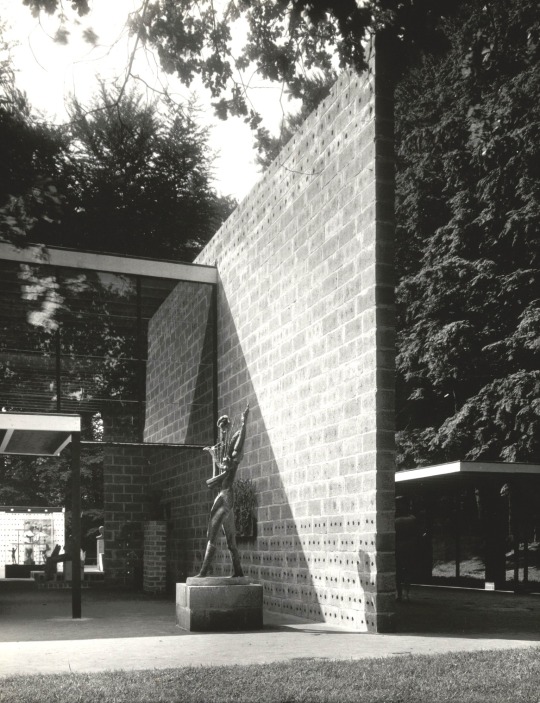
Sonsbeek Pavilion (1954-55) in Arnhem, the Netherlands, by Gerrit Rietveld. Photo by Violette Cornelius.
347 notes
·
View notes
Text


Inspired by the scene from 1954-55 series with Ronald Howard as Holmes!
Absolutely loved it, redrew it with my designs
#art#fanart#digital art#sherlock holmes#sherlock fanart#digitalart#john watson#ttfbs#fencing#the two from baker street#acd holmes#acd sherlock#acd johnlock#dr john watson#gay#bisexual
181 notes
·
View notes
Text

Men at Racetrack, Photo by Ralph Eugene Meatyard, c. 1954-55
81 notes
·
View notes
Text

Bonjour, bonne journée ☕️ 🐩
Le chien vous regarde 🗼Paris 1954/55
Photo de Ihei Kimura
#photooftheday#vintage#photography#ihei kimura#paris#chien#voiture#bonjour#bonne journée#fidjie fidjie
58 notes
·
View notes
Text
There's certainly Something about singularities in Bungou Stray Dogs presenting as massive, myth-derived creatures with more than passing resemblances to kaiju given the setting predates its analog to World War II.
Gojira and the kaiju genre were born in the aftermath of Hiroshima, Nagasaki, and the Lucky Dragon Incident (in which an American hydrogen bomb test rained radioactive ash on a Japanese fishing boat and much of the South Pacific). Life form singularities (like Chuuya and Verlaine), the Seven Traitors, the Transcendants, Mori's fixation on skill-based warfare, and everything else about the Great War all indicate that skills are akin to nuclear arms.
But unlike nuclear arms, skills are generally framed as intrinsic to their user. They're neurological; as much as part of skill users' wiring as the rest of their synapses. Even for Kyouka, whose skill was inherited but not fully integrated, her skill more resembles hereditary neurochemical wiring than it does nuclear proliferation.
Gojira (1954) ends with Dr. Serizawa's promise that hydrogen bombs would always assure nightmarish, monstrous manifestations of the horrors of war. You'd think Dazai's gift, then, would be the enigmatic focal skill of the series; he's capable of nullifying hydrogen bombs, after all.
But it's Atsushi and his celestial Byakko that Shibusawa calls the antithesis of all other abilities. And, as explained in 55 Minutes, Byakko doesn't heal or regenerate Atsushi, it negates his wounds. Atsushi isn't only a particularly tenacious shounen protagonist, Byakko compels him to stand when he's been cut down. When Atsushi is at the edge of death, Byakko consumes him completely, and Atsushi is lost within him, moreso than even Chuuya is in his Corruption state (Chuuya is fully conscious in Corruption— if Atsushi is conscious, he's either repressing or sluggishly recalling the memory of what occurred). Akutagawa also mentions during the Cannibalism arc that Atsushi's claws cut through skills themselves (even Rashoumon, which eats space). Akutagawa also becomes aware, in 55 Minutes, that Byakko can be triggered by Atsushi's peril, and Akutagawa does so to negate the manifestation of a seemingly transcendant skill that otherwise had utterly defanged them (although he seems sorry to have to do it).
Nevertheless, although Atsushi's Byakko seemingly negates the metaphorical horrors of the Great War illustrated by the others and their relationships with their skills, it's Atsushi who posits that perhaps skills aren't innate. He says to Kunikida, "Maybe they come from somewhere else and stick to us. Maybe they're something we can't understand... I don't really know how to put it into words, but that's how I feel."
Much of 55 Minutes is colored by Atsushi's fear of Byakko and his understanding that Byakko could devour him. His fear is seemingly validated by the antagonist, a manifestation of a skill that seemingly swallowed its human. But although textually consistent with his expressed fear, Atsushi's tone, demeanor, timing, and thought processes from when he speaks that line until the light novel ends aren't. His musings reflect his namesake's exploration of and uneasy relationship with the nature of existence, which he understood to be constructed by one's culture and environment better than most due to his somewhat rootless childhood.
I think it's interesting that someone with a skill capable of cutting through other skills, negating wounds, and antithesizing all skills challenges whether skills are innate at all. And if they're not, what does that imply about the parallels between skills, the horrors of war, and the fear of nuclear holocaust?
It's important to me that the scars of American imperialism and disregard for the sanctity of life are not erased from the narrative when discussing the world wars and nuclear proliferation. So I hesitate to posit anything about what skills may be in Bungou Stray Dogs that is too abstracted from trauma wrought by Western imperialism, Japanese imperialism, or the horrors of World Wars I & II. But perhaps that's it; when Atsushi speculates that skills are something that sticks to you, I'm reminded of how trauma has shaped and informed his own. He is certain that Byakko's negation and restless hunger are connected to his birth and subsequent suffering. At first, I thought we were being teased with his early background. But there's no need to tease; the reason so many characters in Bungou Stray Dogs are orphans directly relates to the Great War and the generational trauma still reverberating in its aftermath, and amid the threat of another, even more destructive war.
Perhaps Atsushi was implying that skills are constructs born not from any innate self, if there's such a thing, but from traumas, experiences, needs, cultures, and environments. Which is to say that skills aren't separable, exactly, from their users, but they're not innate either. They're like our personalities: immutable once shaped in the crucible of our most formative years, but nevertheless reflections of not only ourselves, but of what we need and who we become when confronted by others, in all of their beauty and horror.
Thus, perhaps it isn't Atsushi's skill that's so very antithetical to all others. It's his understanding of it, his ability to cut through to others, his compassion, his cowardice, his curiosity, and his separation from his sense of self that both inflicted him with Byakko and which will allow him to transcend it to become who he desires to be. It reminds me that, shortly before his death, his namesake decided to become a writer. And that although he wrote and lived only briefly, his sincerity, thoughtfulness, and introspective skepticism cut, and continue to cut, with a brilliance emblematic of life.
Anyway. Atsushi is both the main character and protagonist of Bungou Stray Dogs. Dazai knows this, too; even if he can nullify Byakko, he's just as impacted by Atsushi's brimming earnestness as everyone else Atsushi encounters. Atsushi liberates the narrative so that it's not a warning that the horrors of war will proliferate so long as we are capable of mass destruction, but instead it's a promise that hope needn't be intrinsic to persist all the same.
#bungou stray dogs#bsd#bsd atsushi#atsushi nakajima#bsd meta#this was all sleep deprived stream of consciousness#but it helped me untangle my nagging fixation on 55 Minutes and Dead Apple#the last sentence does my actual understanding of this thought's thesis an injustice#but im too sleep deprived to articulate myself with any precision so itll have to suffice#i apologize for the timing#but i also dont#because nakajima atsushi's body of work is reviving my skeptical curious optimism lately
124 notes
·
View notes
Text
Hot Vintage Stage Actress Round 1


Bea Arthur: Lucy Brown in The Threepenny Opera (1954 Broadway); Vera Charles in Mame (1966 Broadway)
Rita Moreno: Ilona Ritter in She Loves Me (1964 West End); Iris Brustein in The Sign in Sidney Brustein's Window (1964 Broadway)
Propaganda under the cut
Bea Arthur:
I will leave this one to your discretion, since she's more well-known for her TV career, but I think Bea counts as a stage star too. Her career began on stage! She made her Broadway debut as Lucy Brown in The Threepenny Opera (1954-55), had a very prolific curriculum, and won a Tony Award for Best Featured Actress in a Musical for her critically acclaimed performance as Vera Charles in Mame.
As for why you should vote for her... I mean, just take a look at her. She had style, she had class, she emanates sheer elegance, her regal poise is the stuff of legends. I beg you to look up videos of her performances both to hear her voice (she had the most wonderful deep contralto voice, and a unique way of singing that made all her musical performances so captivating!) and to watch her in motion: her hands alone are a DELIGHT to watch. She's everything and as a wee lesbian I cannot help but adore her.

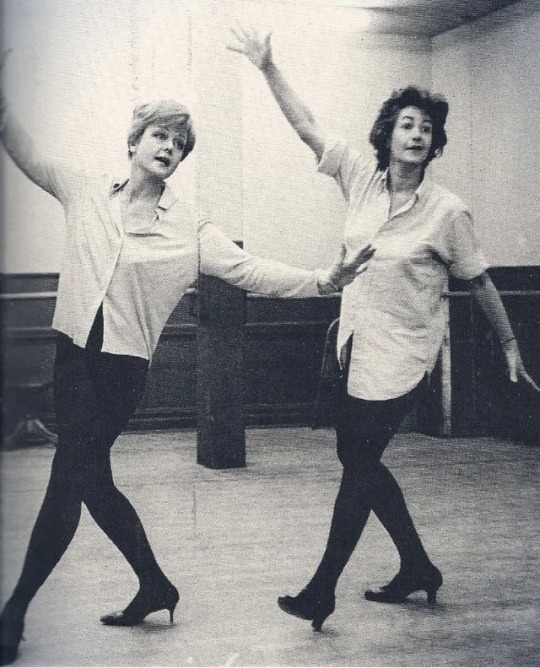
with fellow hottie Angela Lansbury. Look at that spunk! Look at that smile!

once again with Angie in Mame. Her stares are iconic.
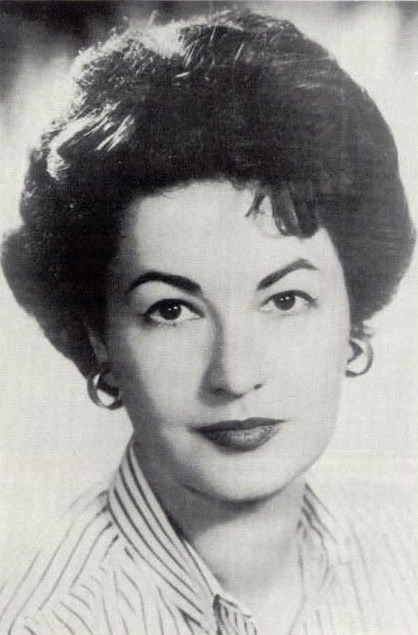
I'm sorry, I couldn't find a cut version of this one online, but I have to submit it anyway because. Her eyes. Her soft smile. Take one look at her and tell me you wouldn't immediately fall on your knees and beg her to marry you.
Rita Moreno:


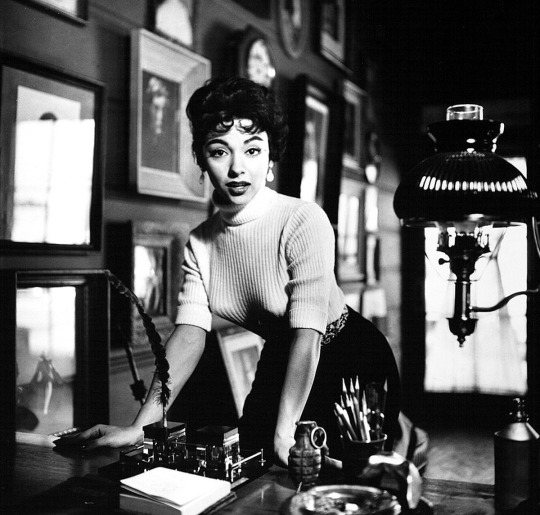
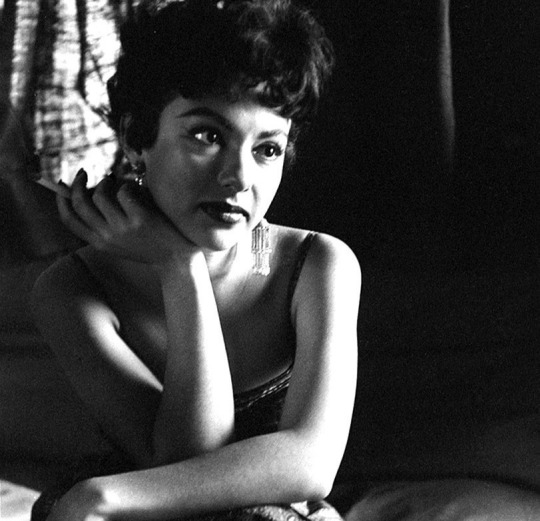



#vintagestagehotties#vintagestagepoll#vintage tournament#vintage poll#bea arthur#rita moreno#ladies round 1#vintage ladies
35 notes
·
View notes
Text


Renée Breton wears “Angélique”, a pale pink satin evening dress. By Christian Dior. Haute Couture Collection Fall/Winter 1954-55.
Renée Breton porte "Angélique", une robe du soir en satin rose pâle. Par Christian Dior. Collection Haute Couture Automne/Hiver 1954-55.
Photo Willy Maywald
#christian dior#collection haute couture#fashion 50s#1954-55#french designer#french style#fall/winter#automne/hiver#renée breton#willy maywald#angélique#evening gown#robe du soir#satin dress
70 notes
·
View notes
Text

Henri Matisse (1869 –1954) Study for Wildlife, 1905
Oil on canvas, 55 x 46 cm. Musée des Beaux-Arts, Grenoble.
52 notes
·
View notes
Text
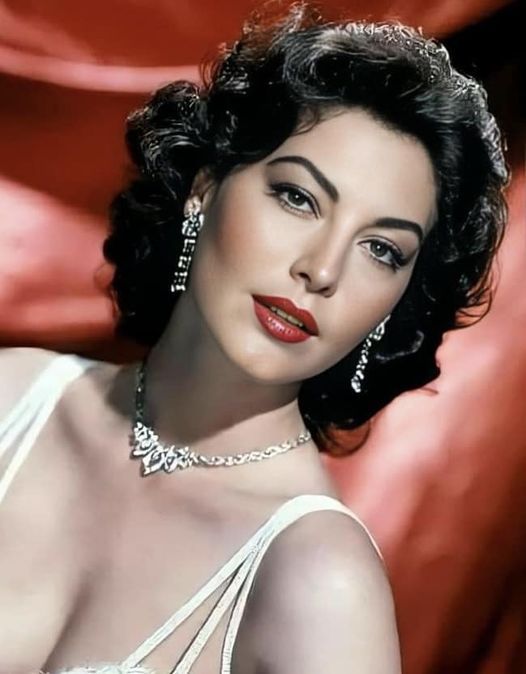
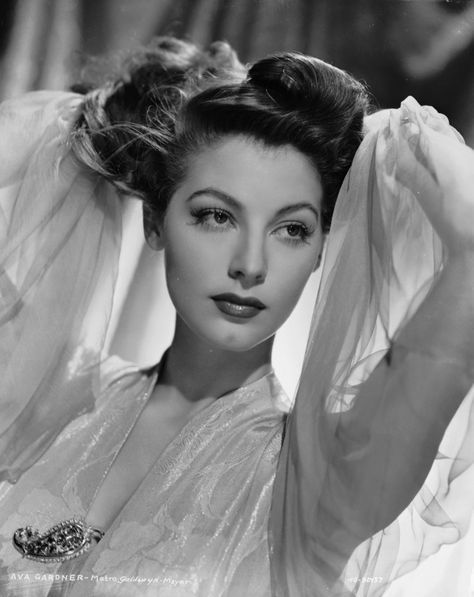

Ava Lavinia Gardner (December 24, 1922 – January 25, 1990) was an American actress. She first signed a contract with Metro-Goldwyn-Mayer in 1941 and appeared mainly in small roles until she drew critics' attention in 1946 with her performance in Robert Siodmak's film noir The Killers. She was nominated for an Academy Award for Best Actress for her performance in John Ford's Mogambo (1953), and for best actress for both a Golden Globe Award and BAFTA Award for her performance in John Huston's The Night of the Iguana (1964). She was a part of the Golden Age of Hollywood.
During the 1950s, Gardner established herself as a leading lady and one of the era's top stars with films like Show Boat, Pandora and the Flying Dutchman (both 1951), The Snows of Kilimanjaro (1952), The Barefoot Contessa (1954), Bhowani Junction (1956) and On the Beach (1959). She continued her film career for three more decades, appearing in the films 55 Days at Peking (1963), Seven Days in May (1964), The Bible: In the Beginning... (1966), Mayerling (1968), The Life and Times of Judge Roy Bean (1972), Earthquake (1974) and The Cassandra Crossing (1976). And in 1985, she had the major recurring role of Ruth Galveston on the primetime soap opera Knots Landing. She continued to act regularly until 1986, four years before her death in 1990, at the age of 67.
In 1999, the American Film Institute ranked Gardner No. 25 on its greatest female screen legends list.
30 notes
·
View notes
Text

Walter Zeller
Isle Of Man T.T. // 1954-55
#motorcycle#walter zeller#motolegends#isle of man tt#road race#road racing#sport bike#racing#motorsports#ride hard or go home#built for speed#experience speed#classic motorcycle#1954#1955#please reblog#moto love#lifestyle
37 notes
·
View notes
Text
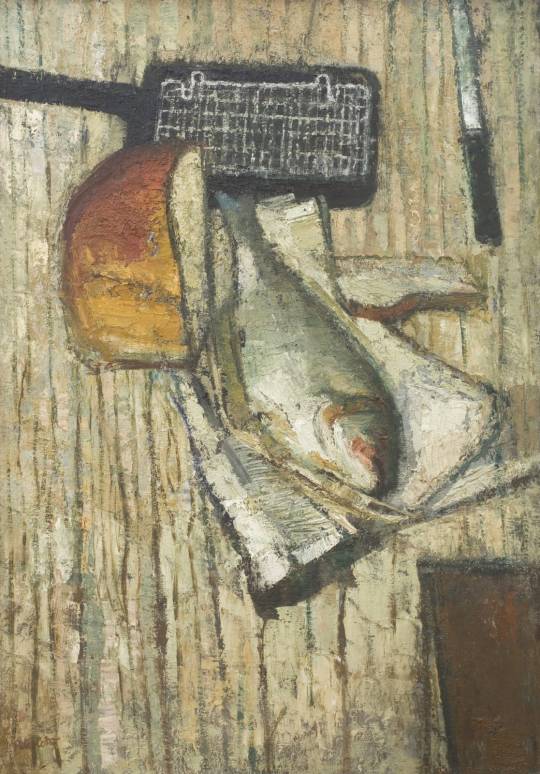
Fish with Grill - Peter Coker , 1954-55.
British, 1926 - 2004
Oil on hardboard , 84 x 59 cm. 33 1/8 x 23 1/4 in.
77 notes
·
View notes